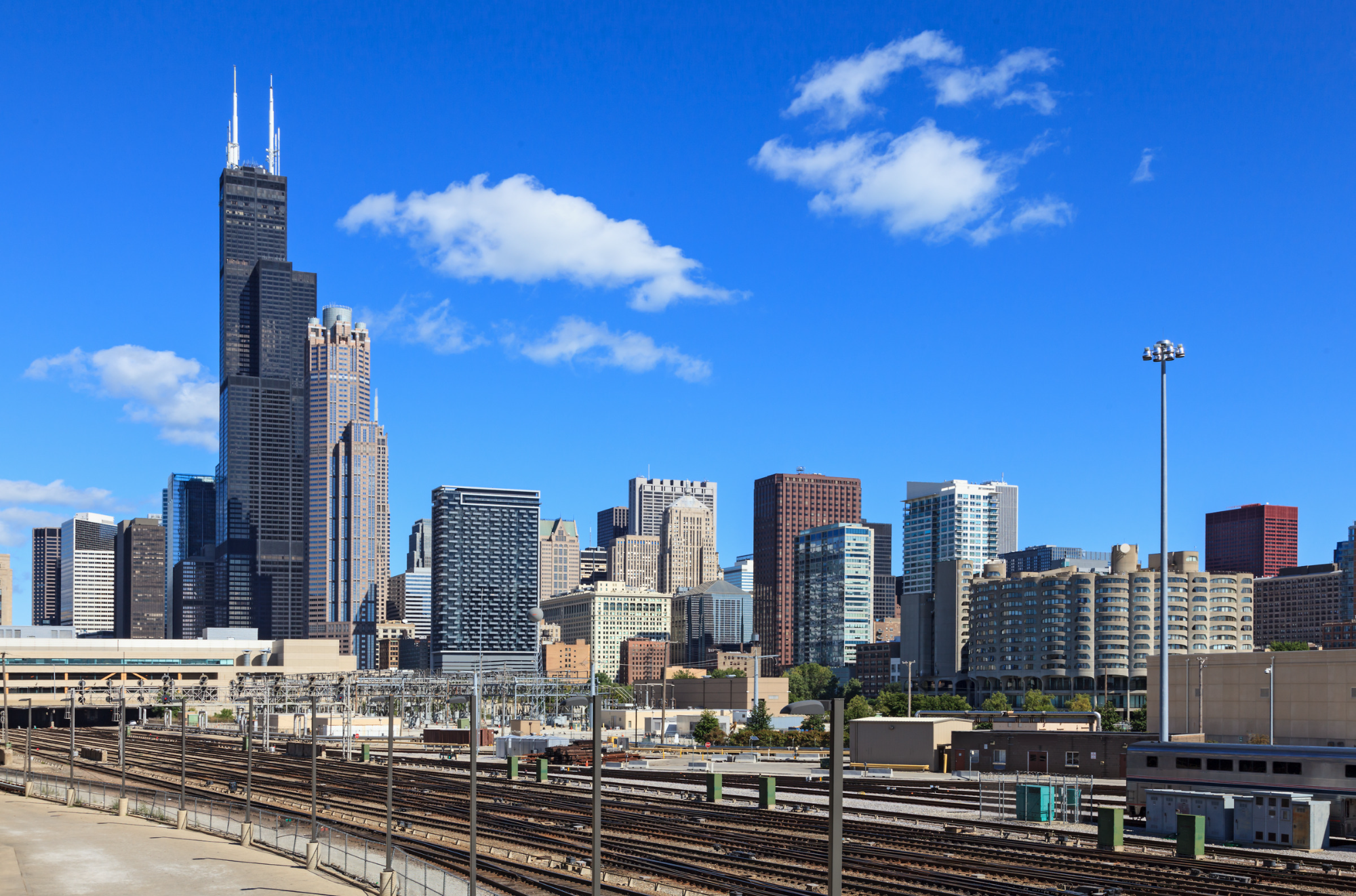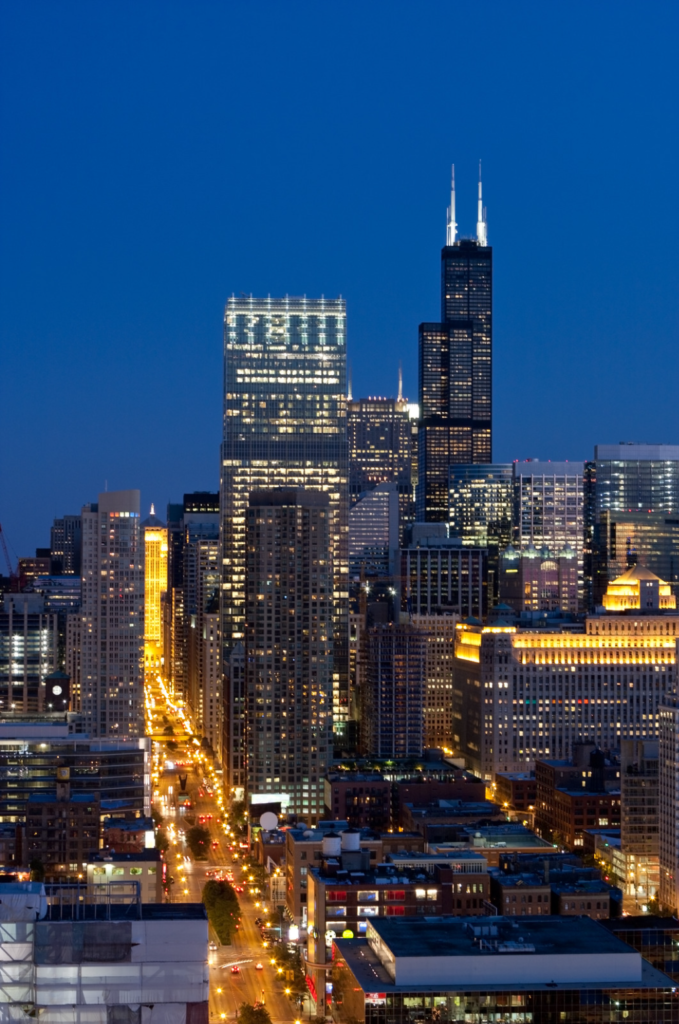
Iconic Chicago: Sears Tower
Published on June 1, 2023
Our monthly series Iconic Chicago looks at some of the most famous locations in our city. We’ll explore the history of these places and why they have earned the love of residents and tourists alike. The latest installment of Iconic Chicago explores the history of the Sears Tower.
By Dave Lifton (@daveeatschicago)
From 1973 until 1998, the Sears Tower at 233 S. Wacker Dr. reigned as the tallest building in the world. Although it has since been surpassed and rebranded as the Willis Tower, the skyscraper still rises majestically over the Chicago skyline and thrills visitors with views from its Skydeck.
Since 1906, Sears, Roebuck & Co. had occupied a campus in North Lawndale on the West Side that housed its headquarters and mail order facilities. But by the mid-1960s, the offices were outdated and the corporation, then the world’s largest retailer, decided to relocated to the Loop. A spot at S. Wacker Dr. between Adams St. and Jackson Blvd. was chosen because of its proximity to both the major highways and rail lines. Acquiring the land required Sears to buy 15 buildings from 100 owners and pay the city $2.7 million to close off that block of Quincy St.

Sears’ intention was to occupy the lower half of the building, and wanted large, open floorplans. But those involved with the design felt that the type of tenants that would occupy the upper floors would probably want a greater percentage of windowed offices.
Architect Bruce Graham and structural engineer Fazlur Rahman Khan of Skidmore, Owings & Merrill took inspiration from an unlikely source. Graham noticed the way cigarettes emerged from a pack at varying heights and had a breakthrough. They decided to build the tower as nine sections, with steel wrapped around them to comprise a single, strong unit that works together to mitigate the effects of the wind. This would allow them to have setbacks at the 50th, 66th and 90th floors, with the central and west-central sections rising to 110 stories. This system Khan pioneered, called “bundled tubes,” would change the way skyscrapers were built in the future.
Ground was broken in August 1970 and, on May 3, 1973, the Sears Tower topped out at 1,451 ft. It was officially opened that September when the first Sears employees moved into their new home.
By June 1974, the Skydeck had opened on the 103rd floor. At 1,353 ft., it’s the highest observation deck in the United States and, on clear days, offers views of up to 50 miles in all directions.
Two men have successfully scaled the Sears Tower. The first was Dan “Spider-Dan” Goodwin who, on May 25, 1981, wanted to call attention to how fire departments were ill-equipped to handle emergencies in skyscrapers. Dressed as Spider-Man, the 25-year-old took seven-and-a-half hours to reach the top. Upon completion of the climb, Goodwin was arrested, charged with disorderly conduct and fined $35.
Eighteen years later, a French professional climber named Alain Robert needed little more than an hour to duplicate SpiderDan’s feat. As with Goodwin, Robert was also arrested at the top, and charged with criminal trespassing and failure to use a safety net or device while conducting an aerial show.
After having been topped by temporary antennae for almost a decade, two permanent ones were installed in 1982, bringing the total height to 1,707 ft. The western one was extended in 2000 to reach its current height of 1,729 ft.
In the early 1990s, Sears left its namesake tower for a new campus in Hoffman Estates, Ill., and sold the building. By the end of the decade, the Petronas Towers in Kuala Lumpur, Malaysia, had bested the height of the Sears Tower by 30 feet.
Sears’ deal allowed the retailer to retain the tower’s naming rights through 2003, but it wasn’t changed until 2009, when London-based insurance brokerage Willis Group leased 140,000 sq. ft., which changed the name to the Willis Tower. However, many Chicagoans still refuse to call it anything but the Sears Tower.
Later that year, the Skydeck got a boost with the addition of the Ledge, four glass boxes that extend 4.3 feet over S. Wacker Dr., with a fifth added in 2022. The boxes are retractable to make it easy to clean and maintain.
In March 2015, Blackstone purchased the Willis Tower for $1.3 billion. By this time, New York’s One World Trade Center had become the tallest building in the Western Hemisphere. A few years later, the new owners announced the Catalog, a 300,000-sq.-ft. dining, retail, and entertainment complex to occupy the first five floors. After a delay due to the COVID-19 pandemic, the Catalog opened in 2022. Combined with a new, interactive experience about Chicago that leads to the Skydeck’s elevators, the Willis Tower’s future looks brighter than ever.

The Adventure starts when you say it does.
All eATLAS Adventures are designed and built by experienced eATLAS Whoa!Guides. They're always on. Always entertaining. And always ready to go.
Check out our Adventures!